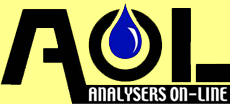A NEW addition to our Chemitec product range for primary and drinking water applications
Our 70 Series Controllers offer an intuitive interface that simplifies measurement calibration and setting of dosing parameters.
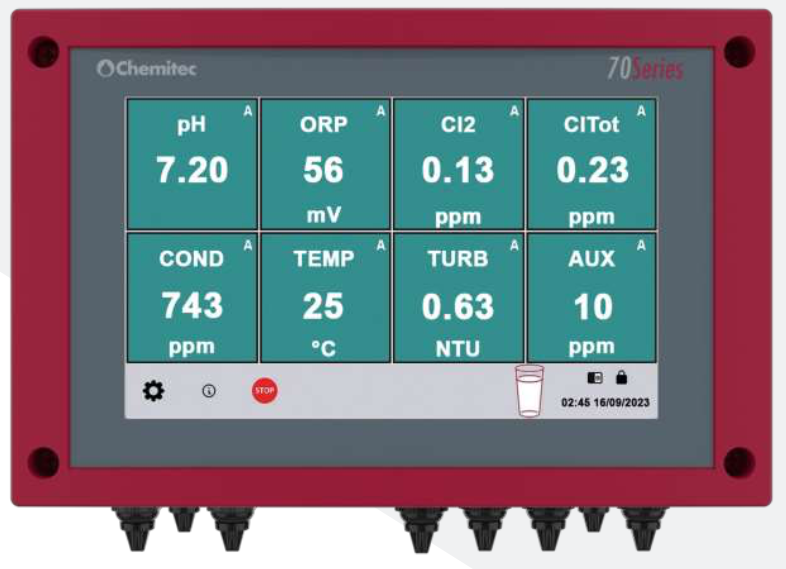 |
As many as 8 parameters can be displayed simultaneously. Available Measurements: pH | ORP | Conductivity | Free Chlorine | Total Chlorine | Temperature | Turbidity | Analog Input (freely programmable) Features include a 7" Touch Screen, WiFi Connectivity, Built-In Data Logger, USB Data Downloads, 8 Relays etc.... |
 |
World class water and liquid analysis instrumentation. For on-line and portable applications. For information, visit our product page |
99 Hits
We are excited to announce the addition of two additional agencies to our product offerings.
Both manufacturers are based in Italy offering the best of Italian quality and design.
 |
World class water and liquid analysis instrumentation. For on-line and portable applications. For information, visit our product page |
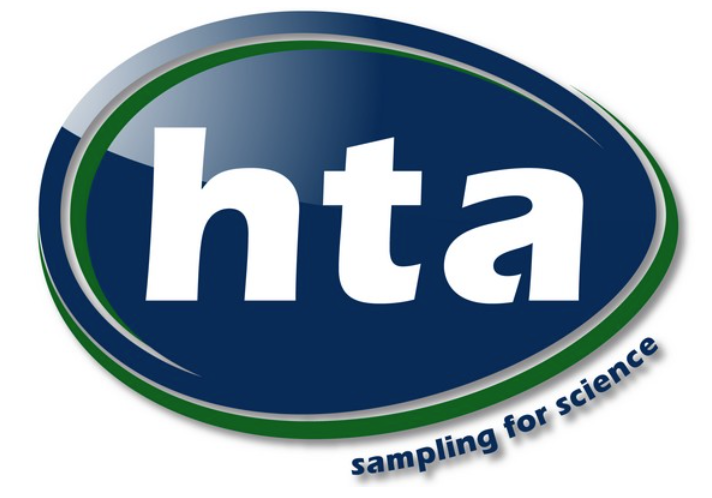 |
Sample preparation workstations and Autosamplers to fit ALL Chromatography and Spectroscopy Analyser systems The sample prep workstations are the fasted growing market. Why use valuable laboratory time when you can automate the action. For information, visit our product page |
97 Hits
On-Line Heavy/Trace Metal Monitoring with our OVA7000 Dual Cell Analyser system.
Monitoring trace/heavy metals was an important process and environmental parameter world wide - and today is probably a critical measurement. With our Modern Water OVA7000 Dual Cell Analyser system, we are able to offer customers real time 24/7 analysis of these important parameters. Up to 10 different metals can be monitored on one Analyser system. It is also possible to offer speciation on certain metals such as As(III); Cr(VI); Sb(III) and Se(V).
Detection limits go down to parts per billion (ppb / µg/L) and turbidity or colour does not affect the method. Power options for the Analyser range from 12VDC and 90-240VAC which makes this a truly versatile Analyser for any site in these power deficient times.
Samples range from waste water, process water, river water to drinking water.
 |
Process Explained: In Voltammetry metals are drawn onto the working electrode when a specific voltage is applied to the water sample under test. When a stripping voltage is applied, the metals return to the sample solution, generating a small current. Each metal has a specific voltage at which it returns to solution, so the metal is identified by its stripping voltage, and the current generated indicates the concentration of the metal in the sample. OVA Dual Cell Specifications: Configuration: Two analytical cells with LCD screen for each cell. IP 65 Rating Power Supply: 12VDC, 90-240 VAC Communication and Outputs: LAN, Modbus, TCP/IP, WiFi, USB, RS232 with the option of 4-20mA |
1271 Hits
Our ChemScan Mini oP Analyser system is the perfect addition to any waste water or water treatment plant. This single parameter on-line Analyser system offers proven reliability with accurate analysis of water and waste water effluent.
This Analyser system has been designed from the ground up to reduce maintenance requirements. The system includes large ID sample tubings to minimise blockages and only needs quarterly reagent refills.
The powerful Automatic Cleaning cycle programmed into the software ensures the system does not suffer from any drift or inaccuracies during analysis.
 |
Features
Measurement Ranges
Applications
Benefits
|
|
|
Multiple data communication interface options are available Enclosure: NEMA 4X |
1268 Hits
Monitoring Total Carbon, Total Organic Carbon and Total Inorganic Carbon species in boiler and condensate return sample streams are important on-line determinations.
Boiler feed and condensate water is an expensive commodity in any refinery. And not to mention the importance of protecting your boilers from corrosive substances such as carbonic acids etc. Our LAR TOC Analyser systems offer closed loop control capabilities with Rapid, True TOC analysis. All carbon bearing contaminants are measured and detected.
Measurement ranges for these Analyser systems can be optimised for each customers requirements and we can cover a range from low ppb levels to high ppm levels. The Analyser is capable of having multiple detectors to auto range and also perform multiple parameters.
With these high temperature combustion systems, the Analyser performs a direct TOC measurement in accordance with DIN, ASTM, EPA and ISO methods. The system is not influenced by the conductivity of the sample.
No catalysts or reagents are required to aid oxidation. A patented gas validation/calibration option is available as well.
High sample temperatures can easily be handled with no pre-treatment requirements.
Rapid response of between 1-3 minutes per analysis means you can make informed process decisions in real time.

Systems are available in a range of cabinet options covering Ex-proof Zone I and Zone II classifications.
1246 Hits
NEW Product Launch
We are excited to announce the launch of our NEW QuickTOCeco Analyser system. This Analyser operates on the same high temperature thermal combustion method as our well proven QuickTOCultra and QuickTOCpurity Analyser systems.
At 1200 degrees Celsius, the sample is completely oxidised, without the need for catalysts or reagents to aid oxidation. Total Carbon (TC) results are available in as quick as 1 minute, with Total Organic Carbon (TOC) results reported in 2-3 minutes.
This Analyser is capable of fast, accurate and reliable True TOC Monitoring. Biological Oxygen Demand (BOD) and Chemical Oxygen Demand (COD) results can be reported on the same Analyser system by correlation.
Applications: Cooling Water, Pure Water, Surface Water, Municipal Waste Water.
To request a data sheet or receive more technical information on this Analyser system, please contact us.
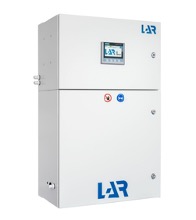
1325 Hits
Introducin our NEW QuickTOCuv Analyser system. This Analyser offers conitnious measurement of Total Organic Carbon (TOC), Total Carbon (TC) and Non-Purgeable Organic Carbon (NPOC) with the capability of correlating the Biochemical Oxygen Demand (BOD) and Chemical Oxygen Demand (COD)
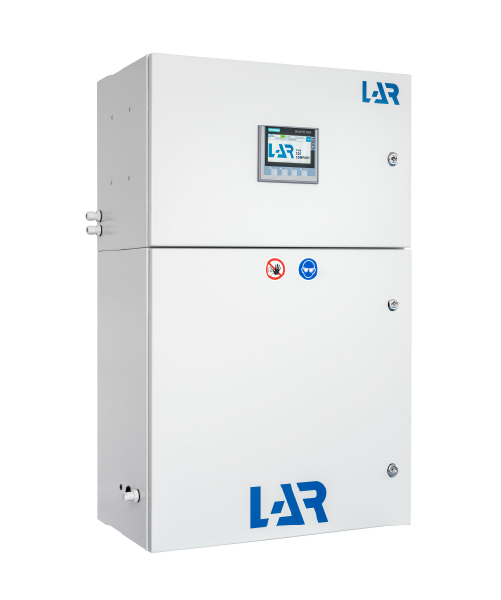
For technical specifications, Contact Us or Visit
1618 Hits
BOD5 Measurements are internationally standardised, and the method is widely used in laboratories. Due to the long incubation times required to perform this classic method, using BOD5 for timely control and monitoring of waste water, is not practical.
With our LAR BioMonitor Analyser system, it will detect rapid changes in oxygen demand and with a response time of 3 - 4 minutes. This Analyser system rapidly measure the total BOD including the oxygen demand for the nitrification as well as the activated sludge respiration (ASR).
Measurement Principle Explained:
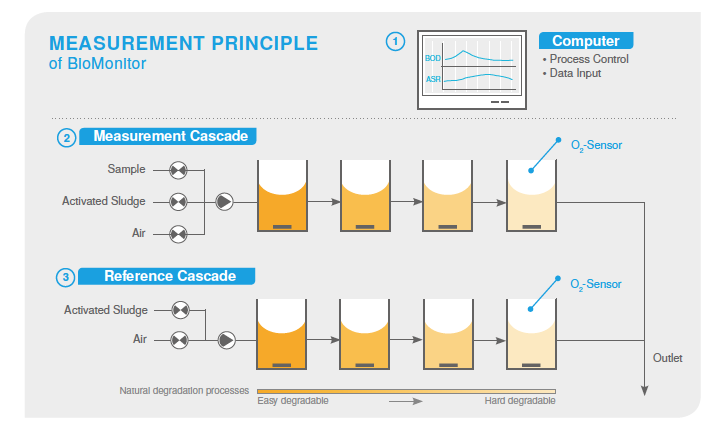
1) Measurement results are displayed on the Analyser screen (human interface).
2) The aerated mixture of activated sludge and sample is pumped through the four reactors. The O2 sensor determines the oxygen consumed during decomposition.
3) The activated sludge is aerated and its respiration is determined (ASR).
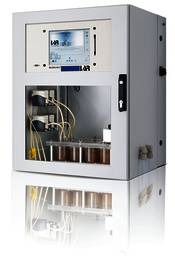 |
Specifications:
|
1849 Hits
Cooling water, regardless of its source, contains various constituents. These occur in different concentrations.
The water quality will impact the operation of the cooling towers. Equipment scaling, corrosion and fouling are some of the concerns.
Our ChemScan® Analyser systems offer a wide range of analytical methods to cover important monitoring parameters for this applciation:
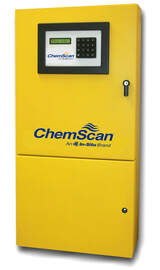 |
Important Water Quality Parameters:
|
3520 Hits
COD monitoring plays an important role when it comes to environmental and process water applications. COD can be determined in the laboratory and on-line using various methods which differ significantly in the required analysis time and consumables and reagents used.
Our LAR QuickCODultra Analyser system uses the Thermal Combustion Method where the sample is completely oxidised at 1200 degrees C. With this method, the COD values are determined without correlation factors as the Analyser system monitors the amount of oxygen consumed during oxidation using a ZrO2 detector.
With this method, NO REAGENTS are required, and results are available in 1-2 minutes. Making this a truly RAPID COD Analyser system, perfect for on-line applications. This Analyser system can handle particles and has a maintenance free sample preparation unit which means a representative sample will be monitored at all times.
Recently a QuickCODultra Analyser system was installed on a blend tank in a process plant. The results generated by the QuickCODultra Analyser was compared to the results on the same samples analysed at the plant laboratory. The trend speaks for itself.
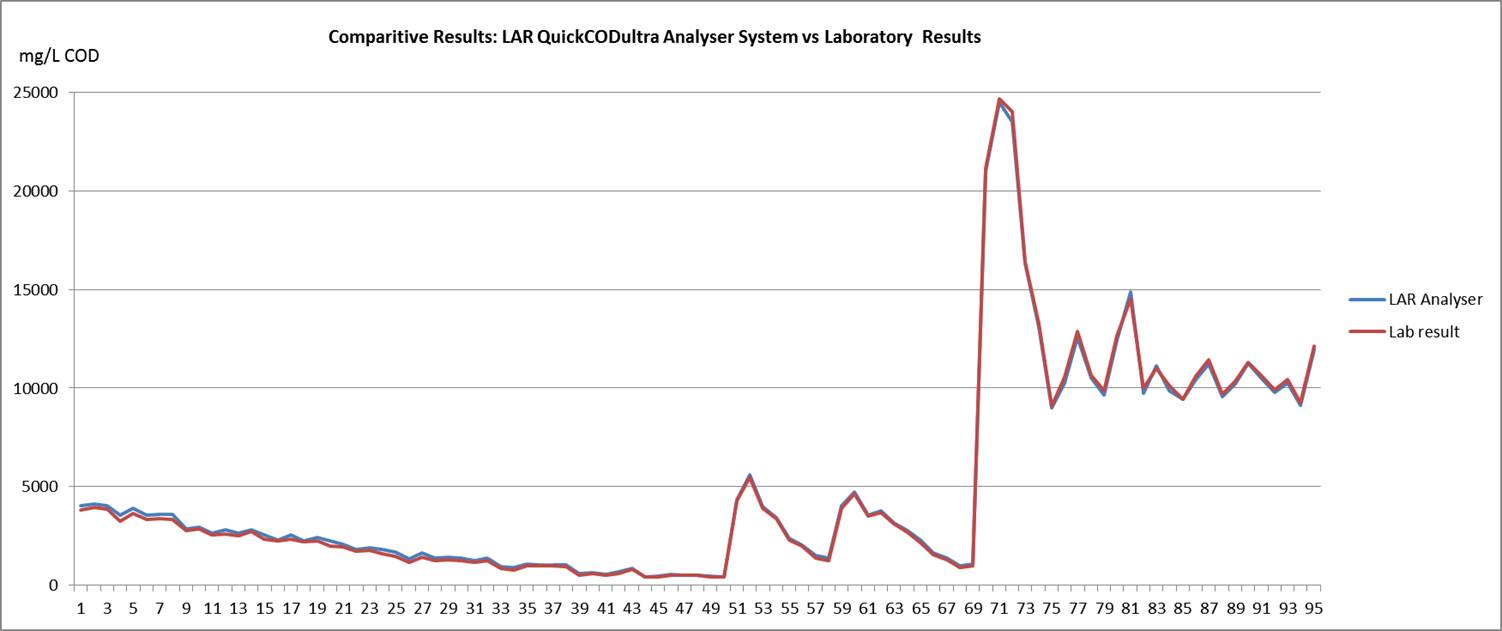
 |
Specifications:
|
5757 Hits
Dissolved Oxygen (DO) Monitoring
Our range of LAQUAact Handheld Dissolved Oxygen (DO) meters offer state of the art portable systems that can be used for laboratory and field applications.
Rugged design—but easy to use and dependable.
Specifications:
- Measures dissolved oxygen (DO) concentration in ppm (mg/L) or % saturation - 0.01 mg/L or 0.1% resolution
- Compensates for sample salinity and temperature and atmospheric pressure
- Auto log data; Built-in memory can store up to 1000 data points
- Auto-shut off (programmable: 1 to 30 minutes)
- Auto-Hold / Auto-Stable measurement
- Large backlit LCD: 52mm x 64mm
- RS232 for connecting to computer and printer
- Casing is IP67 waterproof (for 30 mins immersion in 1m depth of water) and dustproof
- Powered by 2 x AAA (LR03) or Ni-MH batteries or power adaptor
- 2 years meter warranty
- Carry case
Carry case with all accessories are included:
 |
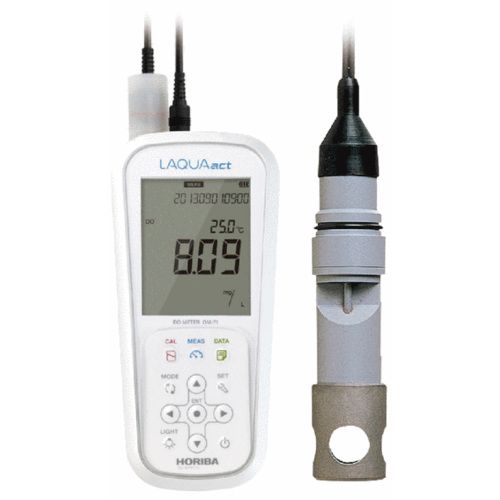 |
For further product information or to request a quotation, please contact us
5161 Hits
Measuring the salinity or dissolved salt content of water is important as aquatic organisms, livestock and crops thrive at different salinity levels. Freshwater has a salinity value of less than 0.5 ppt while seawater has an average salinity of around 35 ppt.
 |
Salinity is the measure of the amount of dissolved salts in water. It is usually expressed in parts per thousand (ppt) or percentage (%). Within an estuary, the salinity levels are referred to as oligohaline (0.5 - 5.0 ppt), mesohaline (5.0 - 18.0 ppt) or polyhaline (18.0 - 30.0 ppt). Near the connection with the open sea, estuarine waters may be euhaline, where salinity levels are the same as the ocean at more than 30.0 ppt. Salinity varies from place to place in the ocean, but relative proportions of most major dissolved constituents remain virually constant. Salinity is often derived from Electrical Conductivity (EC) measurements. EC is measured by passing an electric current between two metal plates or electrodes in the water sample, measuring how readily the current flows between the plates. The use of EC measurements to estimate the ionic content of seawater led to the development of the Practical Salinity Scale 1978 (PSS-78). The PSS-78 has been considered by the Joint Panel on Oceanographic Tables and Standards and iis recommended by all oceanographic organisations as the scale in which to report future salinity data. |
The LAQUAtwin Salt 11 Pocket Meter measures the conductivity value of a sample then converts it to a salinity value based on the salinity standard curve selected. The sensor has two titanium metals coated with platinum black that resist corrosion and a temperature sensor for accurate measurements. The meter is programmed with two standard calibration curves - sea water and sodium chloride (NaCl).
Method
Calibrate the LAQUAtwin Salt 11 Pocket Meter according to the instructions provided with the instrument, using the 0.5% (5 ppt) and 5.0% (50 ppt) NaCl Standard Solutions included in the kit.
Prior to calibration, make sure to select the standard calibration curve (either NaCl or Seawater) and the unit (either % or ppt) depending on your application and reporting unit requirements. If both the sea water curve and ppt unit is selected, calibrate the meter with the 5 ppt NaCl standard. It is best to use 5 ppt and 50 ppt seawater standards if available.
Sample Collection and Measurement
Place drops of water onto the sensor using the pipette which is included in the kit. Make sure the sample sell is completely filled-up with sample and that there are no bubbles formed. Record the salinity reading once it is stable.
Before testing another sample, rinse the sensor with DI (Distilled or Deionised) Water or with the next sample to be tested, and dab a soft tissue to remove the remaining water trapped inside the sample well.
Results and Benefits
Salinity is an important measurment in seawater or in estuaries where freshwater from rivers or streams mixes with salty ocean water as aquatic organisms have varying abilities to survive and thrive at different salinity levels. Saltwater organisms survive in salinity levels up to 40 ppt, yet many freshwater organisms cannot live in waters with salinity levels above 1 ppt.
Salinity affects the dissolved oxygen (DO) levels in water. The solubility of oxygen in water decreases as salinity increases. The solubility of oxygen in seawater is about 20% less than it is in freshwater at the same temperature.
For a copy of the full Application Note - Measuring Salinity of Water, please contact us
6421 Hits
Stories Of Gold
Gold Analysis was undertaken for a client who wanted to determine level of gold in their final effluent. As they were refining gold, they needed to ensure that the gold levels in their final effluent was kept as low as possible. You basically do not want your product to go down the drain.
The instrument used to do this analysis was the PDV6000ultra. This instrument was installed in the laboratory for this determination, but can also be used as a portable analyser in the field. The system runs on VAS software when connected to a PC (the software is supplied free of charge to all users of the instrument).
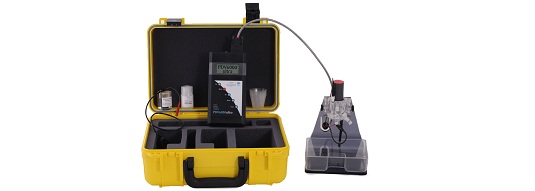
Case Study
A sample was collected from the site. The sample appeared water like with a fine black suspension settled at the bottom. The pH was very acidic at pH 0,65.
The sample was scanned and immediatly saturated the system with a huge Au signal, obvious sample dilution was required.
A x10 dilution was employed and read directly against a pure standard.
The picture below is a screenshot from the VAS Software. The blue line is the sample resonse, the red is the Au Standard response: by simple peak height comparison the result generated an initial value of 30,94 mg/L (ppm) Gold.
Voltammogram of a x10 dilution sample compared to a Au (Gold) Standard:

Now that the sample was quantified, 3 standard additions were performed with the same Au Standard on this sample aliquot and the final resulting value was obtained through linear regression:
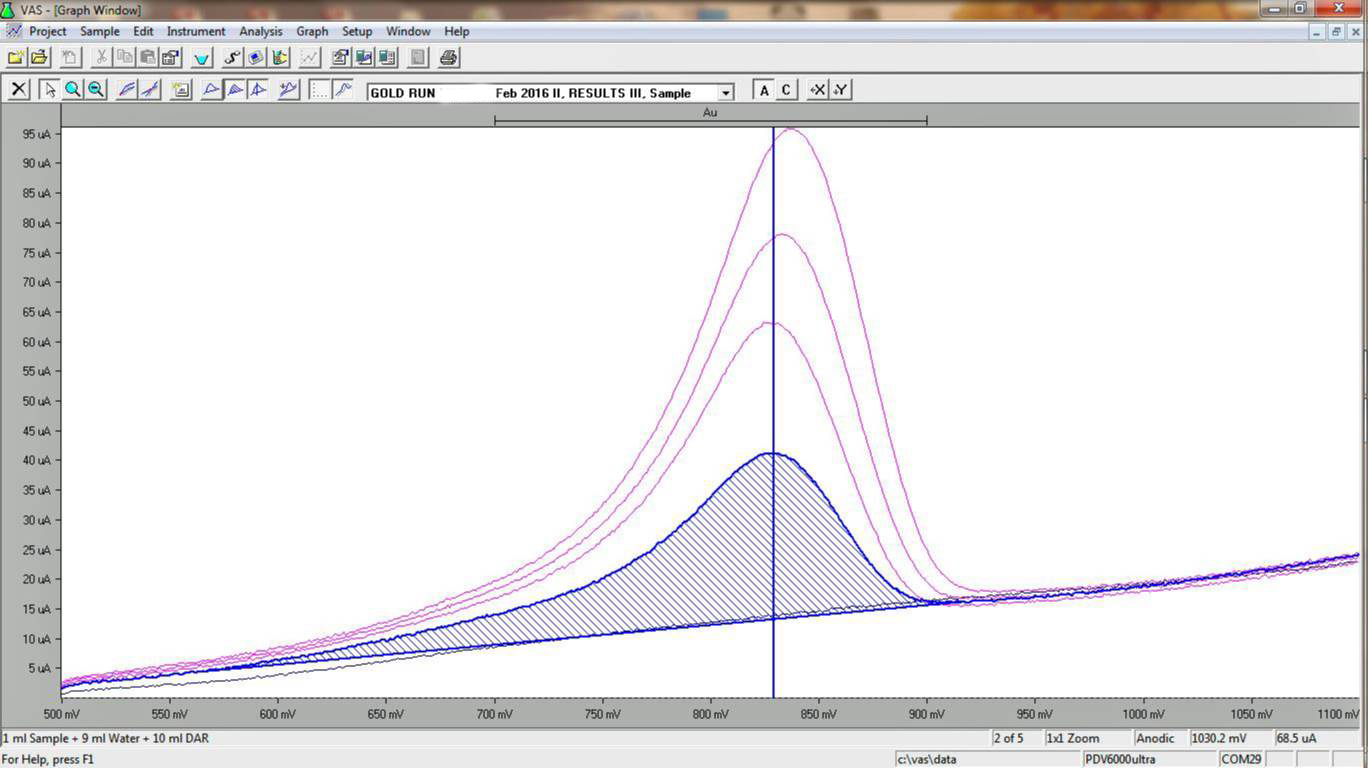
Gold value = 28,89 mg/L (ppm)
Correlation Coefficient = 0,997357
6984 Hits
New Modular Design Mobile Laboratory
Analysers On-Line has built a new Mobile Laboratory combining both Bench systems and On-Line Analysers. The Station is modular in its basic design and can be optimised as required to perform analysis in the field for acid mine drainage (AMD), spill detection or environmental monitoring as some typical examples.
The company has a whole array of suitable equipment for use in the Station or external equipment can be sourced, all enquiries are welcome.
The Station is complete with a suitable pump to provide a fast flow loop if real time monitoring is required. There is a built-in water reservoir and sink for washing purposes. The Mobile Station design is a proven one based and improved on our previous field designs featuring improved insulation and storage facilities.
As the name implies the Station is completely mobile and roadworthy for easy movement to site to site as required by the user’s program of test work.
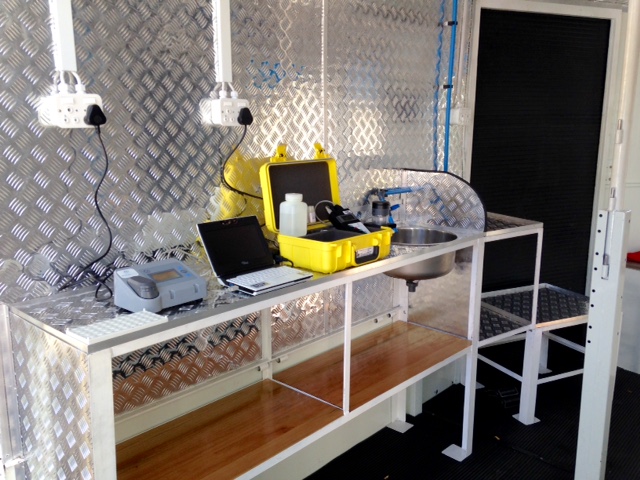
6991 Hits
Mobile Laboratory Monitoring
Since 2013 the MOSA Mobile Laboratory has been successfully used in the field in various projects. With the use of suitable sampling devices, sample monitoring can be performed on-line or at-line. With on-line monitoring the sample water in a river or dam can be monitored 24/7 which allows for trend monitoring and a true picture of any discharge present to be assessed.
This specific Mobile Laboratory is equipped with LAR Instrumentation to monitor on-line a variety of water quality parameters such as TOC, COD, free ammonia, nitrate, pH, conductivity, redox and toxicity. Other additional bench parameters such as phosphate, sulphate and water hardness were also determined in the Station.
During one of these projects, the Mobile Laboratory was used to assist our German partners in monitoring water quality in the influent and effluent water from a mobile WWTP which enabled them to make the timeously adjustments to their plant.

For another project, the Mobile Laboratory was used to monitor on-line water quality of a river inlet feeding a WTP. Other water samples of tributary streams and a WWTP in the area were also analysed successfully and the data obtained could be assessed and reacted on immediately.

For more information on our mobile laboratory offerings, please contact us.
7178 Hits
On-Line Trace Metal Monitoring
Modern Water's Monitoring Division has recently delivered that division's single largest order to date, a purpose-built containerised trace metal monitoring system in the Middle East for a multinational company. To read the full press release......click here
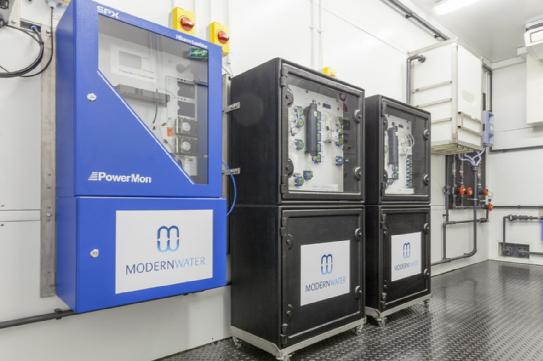
7343 Hits
QuickCOD lab Clean. Fast. Accurate.
The clean COD determination in the laboratory.
Chemical-free.
The environmentally friendly COD analysis.
You can now determine chemical oxygen demand quickly, cleanly and safely with the right measurement procedure – without any chemicals.
Chemical oxygen demand (COD) is one of the most important sum parameters in water analysis. It is considered as a reference for the organic
load of waste water, both in the industrial and municipal sectors. In general, analytical processes are based on the use of different reagents.
However, the safe and environmentally friendly procedure is thermal oxidation.
What COD means. Relevance and versatility.
Chemical oxygen demand (COD) describes the amount of oxygen that is needed to chemically oxidise organic compounds in water, using an (often environmentally dubious) oxidant. The aim is to determine the demand for oxygen, which is primarily required to oxidise organic matter.
This oxygen demand is relevant for the planning, control and cleaning efficiency of waste water treatment plants, as well as a basis for the calculation of sewage charges.
COD measurement methods. Still up-to-date?
The standard potassium dichromate method (DIN 38409 H41-H44) dominates the market. It is also available in a modified form as cuvette tests
(DIN ISO 15705:2003). Here, potassium dichromate is used as an oxidising agent, silver sulphate as a catalyst, as well as sulphuric acid. Mercuric chloride is also used to mask chloride interferences. This risky chemical cocktail is heated after the aqueous sample has been added, and then simmered for approx. two hours. The oxygen demand is calculated from the concentration of residual dichromate. The high consumption of hazardous substances has long been the subject of lively debate.
Contact us to arrange a demonstration or for further product information
1461 Hits
Nutrient pollution in surface waters can cause algae to increase to potentially harmful levels. Algae deplete oxygen and certain species of blue-green and red algae can be poisonous to aquatic life.
Modern Water's algae and algal toxin detection technologies provide fast, accurate and quantitative results.
| Parameters | Detection Range |
Modern Water Product Selection |
| Chlorophyll a | 0.1 to 100ppb | AlgaeChek Ultra - Fluorometer Probe |
| Phycoerythrin (Red algae) | 0.1 to 100ppb | AlgeaChek Ultra - Fluorometer Probe |
| Phycocyanin (Blue-green algae) | 0.1 to 100ppb | AlgeaChek Ultra - Fluorometer Probe |
| Cylindrospermopsin | 0.1 to 2.0ppb | ELISA plate EnviroGard |
| Microcystin |
0.3 to 5.0ppb 0.1 to 1.6ppb |
ELISA tube EnviroGard ELISA plate EnviroGard |
| Okadaic Acid | 0.2 to 5.0ppb | ELISA plate EnviroGard |
| Neo-Saxitoxin | 0.03 to 1.0ppb | ELISA plate EnviroGard |
| Nodularin | 0.04 to 1.0ppb | ELISA plate EnviroGard |
| Brevetoxin | 0.1 to 2.5ppb | ELISA plate EnviroGard |
| Saxitoxin | 0.02 to 0.32ppb | ELISA plate EnviroGard |
Modern Water’s combination of plate and tube test kits offer high sensitivity, quick results and detect a variety of algal species. These immunoassay methods offer a cost-effective solution for high throughput sample testing. A yield of up to 80 samples can be achieved per 96-well microtiter plate, depending on batch size.
Process Explained
Fluorometers
Different molecules absorb and emit light at specific wavelengths. In order to effectively use Fluorometry as a tool for environmental
analysis, the specific wavelengths of the absorbed and emitted light for the target molecules/compounds needs to be known. Modern Water fluorometers use LED light source to excite the molecules and then measure the emittance at the desired wavelength. The intensity of the emitted light provides the concentration of the target compound.
Immunoassay Kits (EnviroGard)
Immunoassay is an analytical method which uses an antibody as a reagent to quantitate specific analytes. The technique incorporates
the binding reaction of a target substance (antigen) with an antibody.
Features:
• Toxin-specific kits
• Use in field and lab
• Low-level detection
• Early warning before harmful levels are reached
• High sensitivity
• Rapid detection
• Easy to use
• Robust
For further product information or to request a brochure, please contact us
7267 Hits
Dissolved salts in water can be particularly challenging for On-Line Analyser systems. With our LAR Process Analysers, we have an innovative method to deal with these challenges in the industrial environment.
Salts are used as primary products, processing material as well as final products in many industries. Generally salts can be devided into organic and inorganic salts and most are soluble in water.
Chemical Oxygen Demand (COD) and/or Total Organic Carbon (TOC) monitoing in many industries are regulated by law or required by the company itself. So the monitoring of these parameters when high salt concentrations are present, can be a huge challenge and historically Analyser systems tend to block up and require many hours or maintenance to clear these blockages.
With our LAR Ultra Analyser system, high salt concentrations can easily be dealt with in the industrial environment with minimal maintenance. Our system works on the Thermal Combustion method with a very high furnace temperature of 1200 degrees C. Any Analyser system using temperatues of 680-1000 degrees C requires catalysts to improve their oxidation potention because the temperature in the reactor is not homogeneous. With our high temperature combustion (1200 degrees C), the temperature exceeds the melting point of common salts. The sample will be completely oxidised and therefore no salts remain in the reactor.
The LAR Process Analyser system with the patented oven operation, is capable of handling high salt applications with ease. High salt concentrations of up to 300g/L NaCl (30%) are easily handled by the robotic arm system and special high salt option. So no additional sample dilutions are required on these Analyser systems.
For further information on these systems please contact us
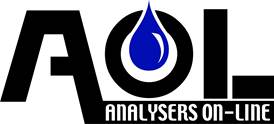
 |
7886 Hits
